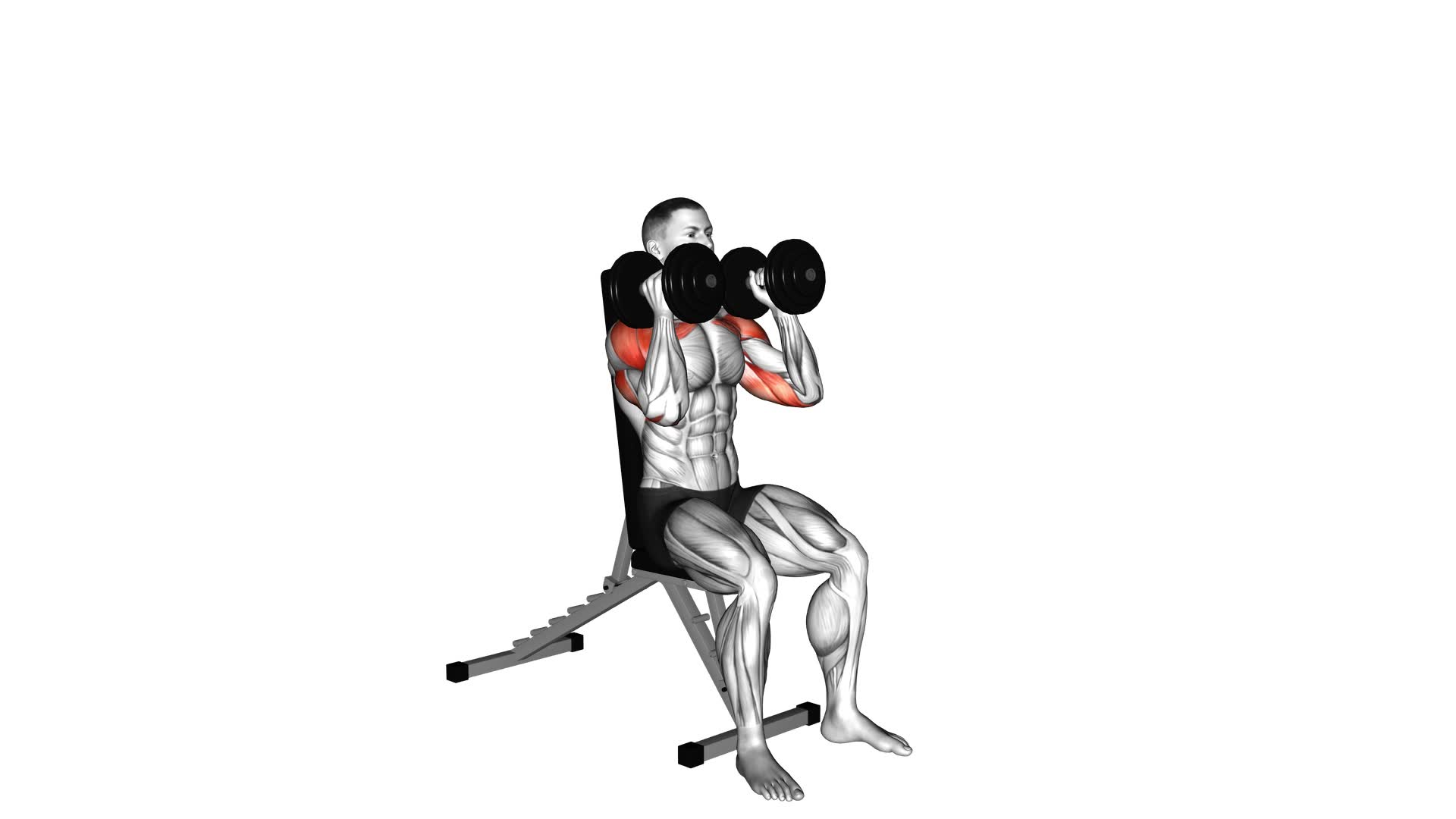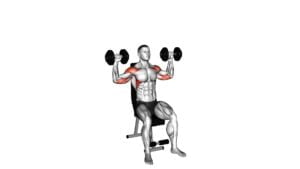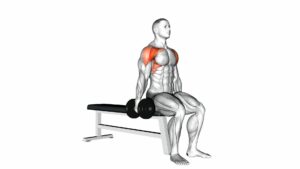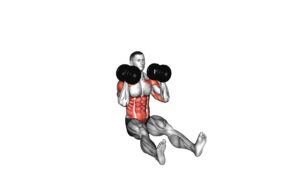Dumbbell Seated Alternate Press – Video Exercise Guide & Tips

Are you looking to strengthen your shoulders and build upper body strength?
Watch This Exercise Video
The dumbbell seated alternate press is the exercise for you! In this video exercise guide, we'll show you the proper technique, common mistakes to avoid, and variations for all fitness levels.
You'll also learn how to incorporate this exercise into your workout routine and get the most out of it.
Get ready to feel the burn and see results with the dumbbell seated alternate press!
Key Takeaways
- Increased shoulder strength and stability
- Development of deltoid muscles
- Targeting of trapezius muscles for shoulder stability
- Reduction of shoulder injury risk
Benefits of the Dumbbell Seated Alternate Press
You will experience increased shoulder strength and stability when performing the Dumbbell Seated Alternate Press. This exercise offers a range of benefits that can enhance your overall upper body strength and improve your athletic performance.
One of the key benefits is the development of the deltoid muscles, which are responsible for shoulder movement and stability. By using dumbbells instead of a barbell, you can achieve a more balanced and controlled movement, allowing for better muscle activation and engagement.
Additionally, the Dumbbell Seated Alternate Press targets the trapezius muscles, which are located in your upper back and play a crucial role in shoulder stability. Strengthening these muscles can help reduce the risk of shoulder injuries, such as dislocations or strains, and improve your ability to perform daily activities that require upper body strength.
In terms of technique, it's important to maintain proper form throughout the exercise. Start by sitting on a bench with your feet flat on the floor, holding a dumbbell in each hand at shoulder level. Press one dumbbell overhead while keeping the other one at shoulder level, then lower it back down and repeat on the other side. Remember to engage your core and keep your back straight to avoid any strain on your lower back.
Proper Technique for the Exercise
To perform the Dumbbell Seated Alternate Press with proper technique, start by sitting on a bench and holding a dumbbell in each hand at shoulder level. Here are some key tips to ensure you execute this exercise correctly:
- Engage your core: Maintain a straight back and brace your core throughout the movement to stabilize your body.
- Press one dumbbell overhead: Slowly extend your arm and press one dumbbell directly overhead, fully extending your elbow without locking it.
- Lower the dumbbell: Control the descent of the dumbbell back to the starting position, making sure to maintain control and stability.
- Repeat on the other side: Alternate sides and perform the same movement with the opposite arm, ensuring equal effort on both sides.
Proper technique is essential to maximize the benefits of the dumbbell seated press. This exercise primarily targets the shoulders, triceps, and upper chest, helping to increase strength and muscle development in these areas. It also engages the core muscles, promoting stability and balance.
While the basic dumbbell seated press is effective, there are variations you can try to add variety to your workout routine. Some common variations include:
- Seated Arnold press: Start with the dumbbells in a neutral grip position, then rotate your palms as you press the dumbbells overhead.
- Seated single-arm press: Perform the exercise one arm at a time, focusing on each side independently.
- Seated alternating front raise and press: Raise one dumbbell to shoulder level, then press it overhead, alternating between arms.
By incorporating these variations, you can challenge your muscles in different ways and prevent workout plateaus.
Now that you know the proper technique and some variations of the dumbbell seated press, let's move on to the next section and discuss common mistakes to avoid.
Common Mistakes to Avoid
To avoid common mistakes and ensure proper form during the dumbbell seated alternate press, it's important to be mindful of your technique and execution. One common mistake to avoid is using too much weight. It can be tempting to go heavy, but using weights that are too heavy can compromise your form and increase the risk of injury. Start with a weight that allows you to perform the exercise with proper form and gradually increase the weight as you become stronger.
Another mistake to watch out for is using momentum instead of controlled movement. It's important to focus on the muscles you're targeting and perform the exercise in a slow and controlled manner. Avoid using your body's momentum to lift the dumbbells, as this can take away the tension from the targeted muscles.
Improper breathing is also a common mistake to avoid. Remember to exhale as you push the dumbbell up and inhale as you lower it back down. This helps stabilize your core and provides better control during the exercise.
Lastly, make sure to maintain proper posture throughout the exercise. Sit tall with your back straight and shoulders down. Avoid slouching or leaning forward, as this can put unnecessary strain on your back and shoulders.
Variations and Progressions for All Fitness Levels
Now that you have mastered the basic form of the dumbbell seated alternate press, it's time to explore variations and progressions to challenge yourself further.
For beginners, there are modifications available to make the exercise more accessible, such as using lighter weights or performing the exercise without weights at all.
On the other hand, advanced individuals can try incorporating more weight, increasing the number of repetitions, or even adding a stability challenge by performing the exercise on an unstable surface.
Beginner Modifications for Variations
Make modifications to the dumbbell seated alternate press to accommodate beginners of all fitness levels.
Here are some exercise modifications that can help beginners ease into this exercise:
- Start with lighter weights: Begin with lighter dumbbells to focus on proper form and technique before progressing to heavier weights.
- Decrease range of motion: Limit the range of motion by not lowering the dumbbells all the way down to shoulder level. This reduces strain on the shoulders and allows beginners to build strength gradually.
- Use a stability ball: Sitting on a stability ball instead of a bench can help engage the core muscles and provide additional support for beginners.
By implementing these beginner modifications, individuals at all fitness levels can safely and effectively perform the dumbbell seated alternate press exercise.
Remember to consult with a fitness professional before starting any new exercise program.
Advanced Progression Options
You can further challenge yourself and continue to progress by exploring various variations and progressions for the dumbbell seated alternate press exercise.
Advanced modifications and training techniques can help you take your workout to the next level. One option is to increase the weight of the dumbbells you're using. This will require more strength and stability in your shoulders and core.
Another option is to perform the exercise on an unstable surface, such as a stability ball or Bosu ball. This will engage your stabilizer muscles even more, providing a greater challenge.
Finally, you can incorporate advanced training techniques such as drop sets or supersets into your dumbbell seated alternate press workout. These techniques will add intensity and variety to your routine, helping you to continue making progress.
Now, let's move on to how to incorporate the exercise into your workout routine.
How to Incorporate the Exercise Into Your Workout Routine
To incorporate the dumbbell seated alternate press into your workout routine, it's important to consider the optimal rep range, proper form tips, and workout frequency recommendations.
Aim for a rep range of 8-12, focusing on maintaining proper form throughout the exercise. Start with a weight that allows you to complete the desired number of reps with good technique, gradually increasing the weight as you become stronger.
Incorporate this exercise into your routine 2-3 times per week for best results.
Optimal Rep Range
To effectively incorporate the dumbbell seated alternate press into your workout routine, aim for a rep range of 8 to 12 repetitions. This range allows you to challenge your muscles without sacrificing proper form and technique.
When choosing the optimal weight for this exercise, select one that allows you to complete the desired number of reps with good form, but still provides enough resistance to make the exercise challenging.
Remember, it's important to prioritize shoulder stability during the dumbbell seated alternate press. Keep your core engaged, maintain a neutral spine, and avoid excessive swinging or arching of the back.
Proper Form Tips
To incorporate the dumbbell seated alternate press into your workout routine with proper form, focus on maintaining shoulder stability while engaging your core and avoiding excessive swinging or arching of the back. By following these guidelines, you can ensure that you reap the benefits of proper form and minimize the risk of injury.
Proper form allows for better muscle activation and development, as well as improved shoulder strength and stability. It also helps to maintain proper alignment throughout the exercise, preventing strain on the joints and muscles.
Common form mistakes to watch out for include using momentum to lift the weights, allowing the elbows to flare out to the sides, and not fully extending the arms at the top of the movement. By being mindful of these form cues, you can maximize the effectiveness of the dumbbell seated alternate press and achieve your fitness goals.
Workout Frequency Recommendations
Incorporate the dumbbell seated alternate press into your workout routine with proper form by following these workout frequency recommendations.
- Start by performing the exercise 2-3 times per week to allow your muscles to adapt and recover.
- Gradually increase the frequency to 4-5 times per week as your strength and endurance improve.
- Aim for a duration of 10-15 minutes per session, focusing on maintaining proper form and controlled movements.
Maintaining a consistent workout frequency is important to see progress and avoid overtraining. However, it's also essential to listen to your body and allow for rest days to prevent injury and promote muscle recovery.
Remember to consult with a fitness professional or trainer to personalize your workout routine and ensure it aligns with your goals and fitness level.
Tips for Getting the Most Out of the Dumbbell Seated Alternate Press
You can maximize your results with the Dumbbell Seated Alternate Press by focusing on proper form and incorporating progressive overload. To enhance your workout, consider incorporating dumbbell seated press variations and advanced dumbbell seated press techniques.
One way to vary your dumbbell seated press is by changing your grip. Instead of the traditional palms-forward grip, try a neutral grip with your palms facing each other. This grip variation can help target different muscles in your shoulders and arms.
Another variation is the Arnold press. Start with your palms facing your body and as you press the dumbbells up, rotate your palms to face forward. This movement engages more muscles, including your rotator cuffs and upper back.
To add more challenge and progressive overload, you can increase the weight of the dumbbells gradually over time. This will force your muscles to adapt and grow stronger. Remember to maintain proper form and control throughout the exercise, even as you increase the weight.
Additionally, you can incorporate supersets or drop sets into your dumbbell seated press routine. Supersets involve performing a set of another exercise immediately after completing a set of dumbbell seated press. Drop sets involve reducing the weight after reaching muscle failure to continue the exercise.
Frequently Asked Questions
How Heavy Should the Dumbbells Be for the Seated Alternate Press?
When doing the seated alternate press, it's important to choose the right dumbbell weight for you. The weight you use will depend on your strength and fitness level. Start with a weight that challenges you but allows you to maintain proper form throughout the exercise. The proper form is crucial to avoid injury and maximize results. Gradually increase the weight as you get stronger.
Can the Seated Alternate Press Be Done With Kettlebells Instead of Dumbbells?
Yes, the seated alternate press can be done with kettlebells instead of dumbbells. By using kettlebells, you can add variety to your workout routine and challenge your muscles in different ways.
The seated alternate press targets your shoulders and triceps, helping to build strength and improve upper body stability. Additionally, using kettlebells requires more grip strength, engaging your forearms as well.
Should I Perform the Seated Alternate Press Before or After Other Upper Body Exercises?
To optimize your pre workout preparation and maximize the benefits of incorporating the seated alternate press into your full upper body routine, it's important to consider when to perform this exercise.
Generally, it's recommended to perform the seated alternate press after other upper body exercises. This allows you to fully engage your shoulder muscles and maintain proper form without being fatigued from previous exercises.
Can the Seated Alternate Press Help Improve Shoulder Stability?
Yes, the seated alternate press can definitely help improve shoulder stability.
By performing this exercise, you engage the muscles in your shoulders, which in turn helps to strengthen and stabilize them.
This exercise also allows you to focus on improving your form and technique, which is important for preventing injuries.
Additionally, there are variations of the seated alternate press that you can incorporate into your routine to further challenge your shoulder stability and enhance your overall upper body strength.
Is It Necessary to Warm up Before Performing the Seated Alternate Press?
Before performing the seated alternate press, it's highly recommended to warm up.
Warming up before strength training has numerous benefits, such as increasing blood flow to the muscles, improving flexibility, and reducing the risk of injury.
To ensure proper form and technique during the seated alternate press, it's crucial to warm up the shoulders and engage the core.
This will help you maintain stability and get the most out of the exercise.
Conclusion
Incorporating the dumbbell seated alternate press into your workout routine can offer a range of benefits for all fitness levels. By utilizing proper technique and avoiding common mistakes, you can maximize the effectiveness of this exercise.
Whether you're a beginner or more advanced, there are variations and progressions to suit your needs. Remember to follow the provided tips to get the most out of this exercise and achieve your fitness goals.

Author
Years ago, the spark of my life’s passion ignited in my mind the moment I stepped into the local gym for the first time. The inaugural bead of perspiration, the initial endeavor, the very first surge of endorphins, and a sense of pride that washed over me post-workout marked the beginning of my deep-seated interest in strength sports, fitness, and sports nutrition. This very curiosity blossomed rapidly into a profound fascination, propelling me to earn a Master’s degree in Physical Education from the Academy of Physical Education in Krakow, followed by a Sports Manager diploma from the Jagiellonian University. My journey of growth led me to gain more specialized qualifications, such as being a certified personal trainer with a focus on sports dietetics, a lifeguard, and an instructor for wellness and corrective gymnastics. Theoretical knowledge paired seamlessly with practical experience, reinforcing my belief that the transformation of individuals under my guidance was also a reflection of my personal growth. This belief holds true even today. Each day, I strive to push the boundaries and explore new realms. These realms gently elevate me to greater heights. The unique combination of passion for my field and the continuous quest for growth fuels my drive to break new ground.







